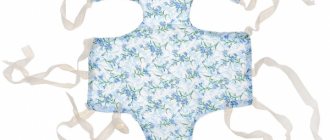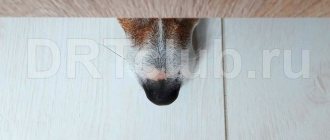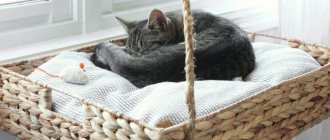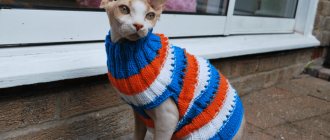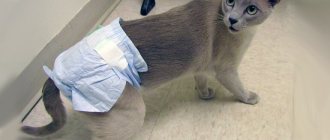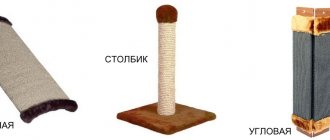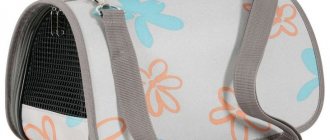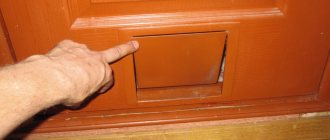Sometimes a cat may need abdominal surgery. The cause may be diseases of the digestive system or sterilization. After the surgical procedure, the animal is put on a special bandage, which is called a blanket or bandage. It prevents the cat from licking the wound and promotes its speedy healing.
Why does a cat need a post-operative bandage?
The most popular use of a post-operative bandage is to protect a cat's suture after sterilization. However, there are other equally important functions:
- Protecting the seam from dust and wool and thereby preventing the inflammatory process.
- Limits the pet's flexibility, thereby reducing the risk of the seam coming apart when licking the groin area and hind legs.
- Preventing various blood-sucking parasites from entering the wound. Special antiseptic wipes are placed under the blanket, which absorb the ichor and prevent the smell of blood from spreading.
Important! The use of a cat bandage is not necessary after sterilization. There are types of sutures over which it is not necessary to wear a special tightening bandage. The cat may also lack the instinct to lick a wound.
DIY cat blanket: step-by-step instructions
When you make it yourself, you have the opportunity to choose the size and choose natural fabric.
Be sure to read:
After sterilization, the cat does not eat or drink for several days: what to do, what to feed
Parameters for the pattern:
- chest volume;
- body length;
- distance between paws.
Using the pattern, cut out the part and begin attaching Velcro or ribbons. When drawing, add a centimeter to the measurements to process the edges.
Recommendation! The edges of the product must be processed.
Ribbons are made from leftover fabric, sewn on by machine or by hand. The ties rarely come undone on their own. The long edges cling to the animal; it is recommended to shorten the finished ribbons. Velcro makes the process of removing the bandage convenient, but they are purchased additionally. They do not interfere with the cat's movement. Over time, the surface becomes non-sticky.
For large wounds, two-layer or three-layer protection is made. A pad is placed in a multi-layer bandage to absorb secretions. Changed periodically. Double or triple blankets are durable. During the sewing process, several layers are connected, leaving a hole for the gasket. Choose lightweight, breathable fabric.
Benefits of a homemade bandage
If the cat is undergoing a serious operation, then the blanket should be taken care of in advance. You can make a bandage for a cat after sterilization with your own hands or buy it at a veterinary pharmacy. The first option will be the most correct for the following reasons:
- A store-bought bandage will most likely not fit and will require “adjustment” to the size of the animal’s body.
- A homemade bandage will be intended for reusable use, unlike a purchased one.
- The material used to make store blankets is thin and gets wet quickly.
Also, don’t think that only a person with sewing skills can make a headband for a cat. Its pattern is quite simple, and the manufacturing process itself will take a little time. You can make a bandage for a cat after sterilization using available materials.
How to care for a cat after sterilization
Caring for a cat during the postoperative period is not limited to just purchasing or creating a blanket. It is necessary to provide your pet with increased attention, especially in the first hours after surgery. You need to pick up the animal from the clinic only in a carrier, having previously covered the bottom with a soft cloth or a special diaper.
Special technology allows the diapers to retain moisture inside for a long time and completely block odor
Carefully place the animal in the carrier, always on its right side, and cover it with something warm or place a heating pad or a bottle of hot water on its back. Do not neglect this, because after anesthesia, the cat’s body loses a lot of heat. Another feature of anesthesia is freezing of the eyes when open. To prevent the cornea from drying out, you need to open and close your eyelids every half hour or use special drops.
At home, leave the animal in the carrier or carefully, removing the edges of the diaper, transfer the cat to the floor. Keeping in mind your exposure to cold and drafts, choose a place close to the radiator, but under no circumstances place it close to the heater; excessive heat can cause bleeding. It is necessary to keep the cat under constant observation for 2–8 hours, waiting for it to wake up. During this time, you can massage your paws with gentle movements to improve blood circulation and speed up recovery from anesthesia. Remember that at the moment of awakening, the cat is capable of harming itself by making unconscious sudden movements or falling.
After the cat recovers from the anesthesia and begins to behave consciously, place a bowl of water and food in front of it. She may not touch the food, because her appetite does not return immediately, but you must definitely monitor it, because this is the main indicator of the animal’s health. It is better to introduce special food for operated animals.
Next, you just need to take care of the seam and observe the behavior of the animal. Check with the doctor who operated on the cat about what medications should be used to treat the wound. Under no circumstances should you engage in self-diagnosis and treatment; a cat’s body is different from a human’s and many medications may simply not be suitable.
The bandage should be worn for 3 days. It should be left only to those animals that are actively trying to lick the wound even through it.
From hosiery
If your cat is small and you have a pair of unnecessary long socks at home, then one of them can become a bandage for the animal. To do this, make four holes for the paws in the selected sock or golf. You need to thread a soft cord at the top and bottom, and cut a small hole at the wound site through which the napkins will be replaced. It is important to choose the size of the golf so that its length matches the size of the pet from the shoulder blades to the pelvic bones.
The disadvantage of this bandage is its good stretchability. In it, the cat can easily bend, which will not provide the necessary fixation of the body.
An alternative option would be to make a bandage from tights. The manufacturing algorithm will be the same, only one more hole for the neck will be required.
Options from improvised means
You can make a blanket from scrap materials, such as tights and socks.
A pantyhose bandage must be made from tights with good density. You can also use trouser legs and sleeves from already unnecessary clothes. Holes for the paws are made in such blanks. After use, such products do not need to be washed, but simply thrown away.
Sock blankets are suitable for kittens and teenage animals, since only they can fit into products of this size. Only a new, never used sock is suitable for production. Slots are made in it for the paws. The hole from the heel should be in the pet's groin. A cord can be used as a tie. This version of the bandage is not very reliable, since the animal can easily take it off.
Using tights, socks and other clothing to make blankets is a simple solution, but the material itself is not very suitable for performing the tasks assigned to the product. Therefore, it is better to sew a bandage from scratch from a more suitable material.
Blanket with ties
If the owner nevertheless decides to sew a bandage for the cat after sterilization, then how to do this will be written below.
The product includes ties on the neck, back, shoulder blades and above the tail. To make it you will need:
- A rectangular piece of breathable material.
- Tape measure.
- Paper for transferring the pattern.
- A little padding polyester.
- Scissors, thread, needle, pencil.
The entire step-by-step instructions fit into eight steps.
- We divide the sheet of paper for the pattern in half with a vertical line.
- We plot the measurements taken relative to the drawn line, where:
A, A1 - length from the neck to the beginning of the tail, plus 1-1.5 cm for the bottom allowance and 4 cm for the collar allowance.
A, A2 - length from the beginning of the neck to the shoulder blades.
A3, A1 - length from the croup to the beginning of the tail.
B, B1 – full neck circumference.
B, B1 - width between the front right paw to the left (measure tightly!)
G, G1 - full chest circumference (measure tightly!)
D, D1 – abdominal circumference under the ribs
Important! Do not forget about allowances for all vertical markings. 0.5–1 cm on both sides will be enough.
- We cut out the resulting pattern and transfer it to the fabric.
- Cut out the workpiece.
- Sew according to the markings, overcast the edges.
- We lay padding polyester in the collar area and sew up the roller.
- We adjust the strings and the blanket itself to the desired length and size during fitting.
- If necessary, we adjust the bandage using darts.
Terms of use
The animal's sutures must be periodically washed and treated during the postoperative period. In the process of performing such actions, the blanket does not need to be completely removed. Only the bottom pair of ribbons is untied. The product must adhere firmly to the cat.
If the bandage is dirty or has strong discharge, it is removed and replaced with a new one. Blankets should be changed regularly to minimize the risk of rotting and wound infection.
The product is completely removed only at the discretion of the veterinarian. If the blanket was made correctly and used correctly, it will ensure a quick recovery for the cat.
How to use a protective blanket
Before putting a bandage on your cat, you need to wash it well, rinse it several times without using household chemicals, and iron it on both sides. You need to put on the blanket very carefully. If your cat tries to remove the bandage, you can loosen a few ties for a while. The cat should be calmed down, picked up, stroked, and then tightened the product again as expected. Practice shows that after 3-4 times the pet becomes resigned to the bandage.
If the cat turns out to be one of the typical ones, and continues to try to take off unusual “clothes”, then all that remains is constant vigil near it.
Important! It is necessary to remove the bandage every day and carefully inspect the seam. Even natural cotton fabric disrupts air circulation and can cause suppuration. In this case, you will need to change antiseptic wipes more often. Under no circumstances should you tighten the bandage too much. Yes, it should hold the seam tightly, but not overtighten it. It would be better if the blanket was tied looser than it would become unbearably tight for the animal. If the bandage is heavily soiled, it must be washed.
A postoperative bandage is an important aid for the correct and rapid rehabilitation of a cat after abdominal surgery. However, when making it or choosing it in a store, you should always remember that the product should help and not cause harm or additional discomfort to the animal. Therefore, it is always worth paying attention to the size of the blanket and the fabric from which it is made. Then the bandage will definitely contribute to the fact that the postoperative scar will heal within 5-7 days after the surgical procedure.
When and who needs a blanket
Most cats try to lick the stitches after surgery, which leads to many negative consequences. Therefore, if the cut is accessible, it needs to be secured. Classic sterilization is carried out along the white line, with the seam located in the very center of the abdomen. If the operation is performed laparoscopically, the blanket can be abandoned.
In addition, clothing is needed for all abdominal operations, as well as for operations on the mammary glands. Can be used for hygienic purposes and also as insulation.
Instructions for putting on
most often the blanket is put on the cat right in the veterinary clinic
Most often, the blanket is fixed to the cat’s body using ties, but there are also options on sale with Velcro and zippers. It is easier to dress an animal in a bandage with Velcro or a zipper, but such products are usually much more expensive.
As you already know, most often a blanket is put on a cat right in the veterinary clinic; in most cases, at this time the animal is still under anesthesia or only partially conscious. In this state, the purr offers no resistance, which greatly simplifies the task. If difficulties arise, seek help from the veterinary clinic staff. Now the main thing for you is not to make sudden movements when manipulating the animal’s body, be extremely careful - fresh stitches are very easy to damage!
Subsequent times, when removing and putting on the bandage to treat the wound, you will have to deal with an active animal. It is important to act as calmly as possible. If your pet is noticeably nervous, try to calm him down with petting and a gentle voice.
Making a bandage at home
If you have at least a minimal understanding of sewing, then it will not be difficult for you to sew a post-operative bandage for your cat. The main thing in the manufacture of bandages is the presence of correctly located and well-fixing tapes for tying. This will also help to fit it to the body of a cat of any size. A properly sewn blanket does not cause discomfort to the cat when feeding, sleeping and going to the tray.
Where is the best place to start sewing blankets? Without correctly taken measurements of your pet's body parts, the product may turn out to be uncomfortable and ineffective. We take the following measurements:
- body length, that is, the distance between the neck and tail;
- abdominal area from front to hind legs;
- circumference of all paws and tail;
- chest volumes.
Kinds
Do not think that a blanket is the only type of medical bandage. In fact, there are several varieties of it. Different types of blankets differ in their features and design. Let's get to know them better.
Warm
Cats, which are representatives of hairless breeds, often freeze when there are cold seasons outside the window. This not only causes significant discomfort for pets, but can also lead to the development of colds. In such circumstances, a special warm blanket would be an excellent solution. Most often, caring owners of Sphynxes and Cornish Rexes turn to such things. These types of blankets look like simple sleeveless vests.
The best and most comfortable blankets are warm blankets made from soft fabric with large pile. Such things effectively protect hairless or short-haired cats from low temperatures and cold gusts of wind. Even during a walk, your pet will be warm and comfortable in a cozy blanket.
Separately, it is worth highlighting the knitted woolen blankets that fit the body well. These specimens are especially warm and have an excellent warming effect. They are very comfortable for cats and kittens.
Homemade
Among cats and kittens, there are a lot of individuals that suffer from allergic shedding. In this case, the owners constantly have to vacuum the furniture in the house, but this is only a temporary measure - soon all surfaces are again covered with hairs that have fallen from the pet’s body.
In such situations, many people look at hairless cats, mistakenly believing that the lack of hair makes them completely problem-free. Such individuals have another common ailment - profuse sweating. Because of this, stains may remain on upholstered furniture, which can be very difficult to remove completely.
In the above situations, homemade blankets can be a real salvation. These products easily and simply absorb secretions from the body of hairless cats. Wool loss with such blankets is also noticeably limited. This is why homemade products are so popular and in demand today. However, most home models of blankets still fall into the category of interesting animal wardrobe items.
Raincoats
When walking with an animal outside in cloudy weather, it is worth keeping a small raincoat for your pet. Such models, as a rule, have a hood and are fastened under the neck and belly of the cat. Raincoats are made from special water-repellent fabrics, such as nylon or vinyl chloride. Polyamide fiber of rich colors is in no way inferior to transparent film in its properties and characteristics. If a rainstorm suddenly starts, the animal in such a cape will only wet its paws.
Postoperative
Initially, after various operations, cats were given a special Elizabethan collar. It was a large cone that was fixed on the animal’s neck and did not allow it to reach the wound. Of course, such things were very disturbing for the pets and caused unnecessary stress. In addition, pets wearing such collars could not wash their faces properly, and eating in them was problematic - the edges constantly hit the bowl, and the food did not always get into the animal’s mouth. Moving around the house in such a collar was also problematic, it threatened injury: the cat could get caught on furniture, doors or doorframes.
It is not surprising that the blanket has become a wonderful replacement for this outdated device. In such a thing with a zipper or Velcro, the pet can move freely around the house, eat normally, and even play. Although protective mantles may slightly restrict the movements of cats and cats, they still will not prevent pets from leading a normal lifestyle. Thanks to this, the recovery process is much easier and faster.
Rules for tying on an animal
scheme for attaching a blanket to a cat
Let's focus on how you can put a blanket on a cat. First, make sure that the bandage is positioned correctly on the table, the reference points are symmetrical cutouts for the front legs. The cat's head should be slightly in front of them, and the cutouts themselves should be in the area of your pet's front armpits.
A standard blanket has 7 pairs of laces for fixation, symmetrically located along the side edges of the product. They have to be tied on the back of the animal. Considering that you will often have to remove and put on the bandage, you should not make the knots too tight. However, too weak a fixation can create problems: the cat will be able to untie the laces with its teeth and get rid of the bandage.
- You need to tie the blanket correctly starting from the head. Taking the two laces at the front, fix them on the purr's neck.
- The next two pairs of ribbons need to be tied crosswise on the animal’s shoulder blades, that is, the right tie from the third pair is connected to the left tie from the second pair, the right tie from the second pair is connected to the left tie from the third pair. So you should get a crosshair made of ribbons on your pet’s withers.
- The following laces are tied in pairs on the back.
- The last two pairs of ties should be secured crosswise on the back of the animal's body.
When fixing the blanket, do not squeeze the animal’s body too much. If you notice that the cat's movements have become constrained, slightly loosen the lacing. Also make sure that the bandage does not cover the animal’s excretory openings: the anus and urinary tract. Otherwise, due to discomfort, the animal will try to remove the post-operative bandage, and you will be faced with the fact that the blanket will very soon be dirty.
If the wound on your pet’s body is small, it is not necessary to completely remove the blanket to treat it - free only that part of the body where the surgical suture is located, this way you will save your time and your pet’s nerves in the process of fixing the bandage. When tying ribbons, do not leave long ends. Remember that your cat can easily pull them with his teeth, loosening or untying the knot.
It is allowed to remove the bandage for 15-20 minutes 2-3 times a day, especially if the cat does not get used to it well. However, at this time the pet should be under your close attention. When trying to lick stitches and wounds, you must immediately gently prevent this: caress the animal or distract it with food.
It's best to have another blanket just in case. You should not rule out the possibility that your pet may tear the bandage with its teeth or get it very dirty, in which case it will be necessary to replace the bandage.
Features of sewing clothes for cats
One of the features of sewing clothes for cats is the choice of materials. Everything here is very individual, since this particular fabric and this particular style will suit each individual cat. And it’s not just about the breed, but also about the coloring of the pet’s coat, the size of the pet, and even the place it occupies in the owner’s heart.
Cat apron
In any case, special attention should be paid to natural materials. It is also possible to use fabrics with a small amount of synthetic fibers. The best option would be: cotton fabrics, linen, wool, viscose. They are pleasant not only for humans, but also for cats. You should also look at the characteristics of the material: how well it is made, whether it fades in the sun, or whether it deforms after washing.
Bow and dress
Also among the features is taking measurements of cats, which, naturally, differ from dogs, and even more so from humans. Taking measurements from animals is not so easy, since they constantly strive to break free.
McDonald's apron version
What else can you make for your pet?
In addition to blankets, decorative and warming things are often sewn for cats: tuxedos, skirts, light clothes for summer and thick ones for winter. Each requires the use of certain materials and entry-level sewing skills.
Cat skirt
The tuxedo
A stylish accessory that will highlight the elegance of a slender and long cat. This jacket is made according to a simple pattern, but it looks very beautiful, and most importantly, it does not hinder the movement of the animal. For production you will need:
- white fabric (old shirt);
- black fabric (any cut);
- some red cloth;
- Velcro for fixation;
- tailor's tools in the form of scissors, chalk, sewing machine or hand sewing accessories.
Costume for a British kitten
Airy skirt
If a tuxedo is more suitable for keeping warm, then a skirt is more suitable for going out. Usually these outfits are made for show animals, which appear before spectators and judges in original outfits. Skirts as clothing have become increasingly popular lately. The most important thing is that for manufacturing you will need a few materials and ordinary tools:
- a piece of tulle;
- satin ribbon;
- scissors, needle and thread.
You might be interested in this. Patterns for skirts in tiers: the procedure for sewing them yourself
Important! This set is quite enough to make a beautiful skirt for a cat like a tutu without diagrams or patterns.
Pattern of a dress for a cat
Emergency heating
It happens that clothes for a pet are needed extremely urgently and there is not enough time to create patterns, transfer them to fabric and sewing. To quickly warm up, you can use a regular sock. For production you will need:
- one warm sock;
- scissors;
- chalk.
The idea is to make a vest out of a sock. It is very similar to a blanket, but does not require sterility. A tube is made from a sock with holes for the paws. After which it is put on the cat.
Warm sock
Summer minimalism
For the warm season there is no need for warm clothes, so things for summer are aimed at decorating the cat in a certain style. Such accessories can include ties, bow ties, hats and many others. So, to sew a bow tie you will need:
- collar;
- needle, thread and scissors;
- fabric for the butterfly.
Fabrics used
It is better to sew such bandages from several layers of fabric:
- top – decorative or waterproof;
- medium – insulating, made of soft and warm fabric;
- internal - underwear made of delicate knitwear or flannel fabric.
It is best to sew a blanket made of two or three layers with well-stitched edges and ribbons for ties. For the durability of such a product, it is better to take dense cotton fabrics. The ties are cut long, and during the fitting process their excess length is removed so that the animal does not get entangled in them. In order not to disturb the cat once again, you need to determine the location of the paws in advance. If there are serious wounds after sterilization surgery, a multi-layer bandage is placed under the bandage when putting it on.
Dressing up
The functionality and effectiveness of using a bandage for a cat during its postoperative period after sterilization depends not only on the correctness of its cut and manufacture. After surgery, the bandage must be tied correctly and carefully. If the fasteners or ties of the bandage are pulled too tightly, it will be too tight, and this will have a bad effect on the healing processes of stitches and wounds. A very loose tie is also ineffective; it will move, rubbing the seam on the animal, or the cat will pull it off altogether, and also damage the seams.
When dressing correctly, you need to unfold the bandage, straightening all the ties. Then the cat carefully lies down on it and the ties are secured in front near the head and front paws. After this, the back ties are tied in pairs above the paws and they are bandaged in the pelvic area. With different cuts of blankets, there may be a different order of dressing. The main thing after putting on the bandage is to make sure it is properly fixed. To do this, you need to let the cat move around the apartment. If she feels comfortable, moves around freely and does not try to tear off the bandage, then he is wearing it correctly.
It should be noted that there is no need to take off and put on the blanket every day. If you need to treat a seam after sterilization, or change a bandage, you can just untie a few ties. But still, we must take into account that during the period of wearing the blanket, which is 10-14 days, it may be necessary to change it to maintain cleanliness.
However, most cats feel uncomfortable wearing a bandage. They try to get rid of it, gnaw and tear it with their teeth and claws. Therefore, a properly selected fabric for a bandage, especially its upper part, should be relatively durable. If the cat nevertheless takes off the blanket, then first of all you need to inspect the seam and, if necessary, contact a veterinarian. If everything is fine with the seam, you need to carefully put the bandage back on so that it fits tighter.
Be more kind and gentle to your pets during this difficult period for them, pay them more attention and then they will forget about the bandage.
Buy or sew?
You can buy a blanket at a specialized pet store. This is an option when a bandage is prescribed after a major operation, where maximum sterility and quality are required. The advantage of a purchased product: variety of colors, sizes, manufacturers.
The products are made from dense, lint-free non-woven materials. This way they don’t leave hairs and don’t form pellets after lying on the sofa. At the same time, they are easily adjusted and can be cut to fit the size of your pet.
The fabric fibers have a structure that quickly absorbs liquid. This is a big plus for the animal’s postoperative body when the wound is tightly covered with material and is not in danger of getting wet. Another advantage of a medical bandage is that it is not subject to rupture. They have a long service life, tolerate washing well and do not have harmful components that would have an aggressive effect on the pet’s skin.
However, if the owner is not ready to spend a lot of money, and the bandage was not a prerequisite for the doctor, you can make a blanket for the injured cat with your own hands.
Several pattern options
Directly cutting out the blanket involves marking and cutting out holes for the paws on a piece of fabric, in strict accordance with the previously made measurements. Sometimes a pattern of a bandage or blanket is made in the form of a triangle with a hole for the tail at its top. The long sides of the triangle are wrapped around the cat's body along the front legs, and their ends, wrapped around the body, are taken out in front and tied in a knot behind the back. You can make a bandage after surgery with passages only for the front paws and distribute them evenly around the perimeter of the ties, Velcro or buttons. The buttons are very convenient to put on, but can easily come unfastened during use, therefore, they are not recommended.
You can cut out and sew a blanket by placing the cats' paws in small circles and the head in a larger circle. With this cutting, you need to cross the back and front ties. When tying it, you need to be careful not to pull the cat's fur along with the tie. When tying the bandage, you should also leave allowances for free movement of the diaphragm when breathing.
Homemade
Among furry pets, there are also those who suffer from allergic shedding.
The owners have to constantly vacuum the furniture and often comb out the animals, although this does not save the situation. But you shouldn’t envy owners of “hairless” cats. Unfortunately, they have another physiological feature - increased sweating. There are stains on sofas and armchairs that are difficult to remove.
Therefore, pets are dressed in blankets made of light cotton fabric, reminiscent of a robe or T-shirt. Such clothing absorbs skin secretions well and limits hair loss.
A satin blanket will protect furniture from your pet's sweating.
Most home capes still belong to wardrobe items. However, some models are necessary for the daily care of animals with incurable diseases.
When veterinarians discovered a tumor on an elderly cat's mammary gland, the owners were forced to make difficult choices. They did not agree to the operation, which still would not bring recovery.
The pet constantly reached out to the sore spot and licked it. Redness and inflammation began. Then the owners put a loose blanket on the cat. It is surprising that the animal quickly got used to the “cover” and only slightly protested at first.
The tumor, covered with tissue, became less inflamed by the actions of the furry pet. The use of a protective device thus made it possible to extend the earthly existence of a doomed living creature for another year and a half.
Fastening a blanket with a zipper is much more convenient than tying ribbons.
When can I shoot?
When can you remove the blanket after sterilization? Here you should follow the recommendations of your veterinarian.
Important! It is usually recommended to remove it after 10-15 days; the wound usually does not heal faster.
